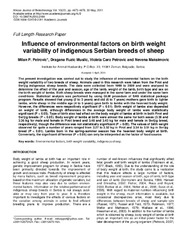Приказ основних података о документу
Influence of environmental factors on birth weight variability of indigenous Serbian breeds of sheep
| dc.creator | Petrović, Milan P. | |
| dc.creator | Ružić-Muslić, Dragana | |
| dc.creator | Caro Petrović, Violeta | |
| dc.creator | Maksimović, Nevena | |
| dc.date.accessioned | 2018-12-14T14:54:54Z | |
| dc.date.available | 2018-12-14T14:54:54Z | |
| dc.date.issued | 2011 | |
| dc.identifier.issn | 1684-5315 | |
| dc.identifier.uri | http://r.istocar.bg.ac.rs/handle/123456789/258 | |
| dc.description.abstract | The present investigation was carried out to study the influence of environmental factors on the birth weight variability of two breeds of sheep. Animals used in this research were taken from the Pirot and Svrljig indigenous sheep breeds. The data were collected from 1999 to 2009 and were analyzed to determine the effect of the year and season, age of the lamb, weight of the lamb, birth type and sex on the birth weight of lambs. Both sheep breeds were managed in the same farm and under the same farm conditions. Statistical analysis was performed by using GLM procedure of SAS statistical package program. Results showed that young (2 to 3 years) and old (6 to 7 years) mothers gave birth to lighter lambs, while sheep in the middle age (4 to 5 years) gave birth to lambs with the heaviest body weight. However, the differences were respectively significant (P (lt) 0.01). Birth weight of lambs also depended on weight of lamb, although differences in the average body weight of lambs were statistically significant (P (lt) 0.05). Type of birth also had effect on the body weight of lambs at birth in both Pirot and Svrljig breeds (P (lt) 0.05). Body weight of lambs at birth were almost the same for both sexes (3.39 and 3.36 kg for male and female in Pirot breed and 3.48 and 3.43 kg for male and female in Svrljig breed, respectively), though the difference was not statistically significant (P > 0.05). The values of birth weight observed for quite a number of years ranged from 3.27 to 3.52 kg in Pirot and 3.34 to 3.51 kg in Svrljig breed (P (lt) 0.01). Lambs born in the spring-summer season has the heaviest body weight at birth. Conversely, the significant difference (P (lt) 0.05) can only be interpreted as the factor of food source. | en |
| dc.publisher | Academic Journals, Victoria Island | |
| dc.rights | openAccess | |
| dc.source | African Journal of Biotechnology | |
| dc.subject | Environmental factors | en |
| dc.subject | birth weight variability | en |
| dc.subject | indigenous sheep | en |
| dc.title | Influence of environmental factors on birth weight variability of indigenous Serbian breeds of sheep | en |
| dc.type | article | |
| dc.rights.license | ARR | |
| dcterms.abstract | Максимовић, Невена; Царо-Петровић, Виолета; Ружић-Муслић, Драгана; Петровић, Милан П.; | |
| dc.citation.volume | 10 | |
| dc.citation.issue | 22 | |
| dc.citation.spage | 4673 | |
| dc.citation.epage | 4676 | |
| dc.citation.other | 10(22): 4673-4676 | |
| dc.citation.rank | M23 | |
| dc.identifier.rcub | https://hdl.handle.net/21.15107/rcub_ristocar_258 | |
| dc.identifier.fulltext | http://r.istocar.bg.ac.rs//bitstream/id/1999/256.pdf | |
| dc.identifier.scopus | 2-s2.0-79957962746 | |
| dc.identifier.wos | 000294612700023 | |
| dc.type.version | publishedVersion |


